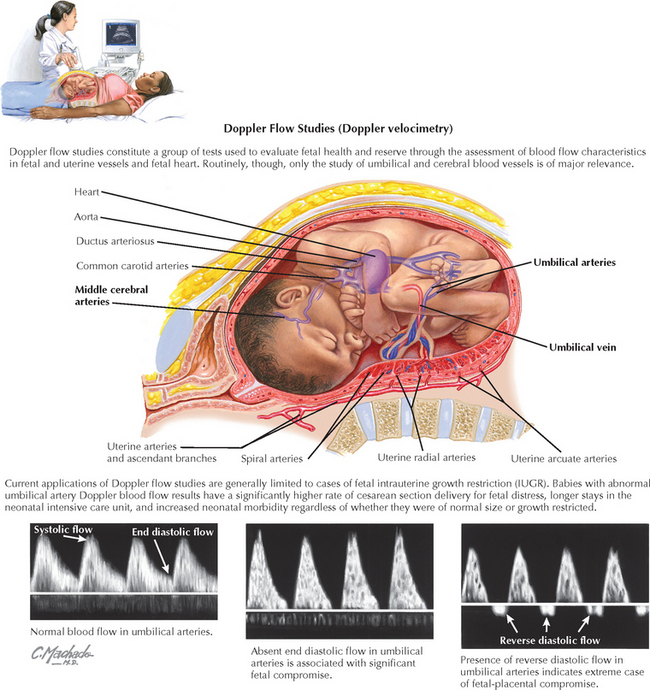Chapter 187 Doppler Flow Studies
THE CHALLENGE
TACTICS
IMPLEMENTATION
Giles W, Bisits A, O’Callaghan S, Gill A, DAMP Study Group. The Doppler assessment in multiple pregnancy: randomised controlled trial of ultrasound biometry versus umbilical artery Doppler ultrasound and biometry in twin pregnancy. BJOG. 2003;110:593.
Newnham JP, O’Dea MR, Reid KP, Diepeveen DA. Doppler flow velocity waveform analysis in high risk pregnancies: a randomized controlled trial. Br J Obstet Gynaecol. 1991;98:956.
Omtzigt AM, Reuwer PJ, Bruinse HW. A randomized controlled trial on the clinical value of umbilical Doppler velocimetry in antenatal care. Am J Obstet Gynecol. 1994;170:625.
Trudinger BJ, Cook CM, Giles WB, et al. Umbilical artery flow velocity waveforms in high-risk pregnancy. Randomised controlled trial. Lancet. 1987;1:188.
Whittle MJ, Hanretty KP, Primrose MH, Neilson JP. Screening for the compromised fetus: a randomized trial of umbilical artery velocimetry in unselected pregnancies. Am J Obstet Gynecol. 1994;170:555.
Williams KP, Farquharson DF, Bebbington M, et al. Screening for fetal well-being in a high-risk pregnant population comparing the nonstress test with umbilical artery Doppler velocimetry: a randomized controlled clinical trial. Am J Obstet Gynecol. 2003;188:1366-1371.
Zimmerman R, Carpenter RJJr, Durig P, Mari G. Longitudinal measurement of peak systolic velocity in the fetal middle cerebral artery for monitoring pregnancies complicated by red cell alloimmunisation: a prospective multicentre trial with intention-to-treat. BJOG. 2002;109:746.
Almstrom H, Axelsson O, Cnattingius S, et al. Comparison of umbilical-artery velocimetry and cardiotocography for surveillance of small-for-gestational-age fetuses. Lancet. 1992;340:936.
Farrell T, Chien PF, Gordon A. Intrapartum umbilical artery Doppler velocimetry as a predictor of adverse perinatal outcome: a systematic review. Br J Obstet Gynaecol. 1999;106:783.
Johnstone FD, Prescott R, Hoskins P, et al. The effect of introduction of umbilical Doppler recordings to obstetric practice. Br J Obstet Gynaecol. 1993;100:733.
Karsdorp VH, van Vugt JM, van Geijn HP, et al. Clinical significance of absent or reversed end diastolic velocity waveforms in umbilical artery. Lancet. 1994;344:1664.
Khoury J, Haugen G, Tonstad S, et al. Effect of a cholesterol-lowering diet during pregnancy on maternal and fetal Doppler velocimetry: the CARRDIP study. Am J Obstet Gynecol. 2007;196:549.e1.
Konchak PS, Bernstein IM, Capeless EL. Uterine artery Doppler velocimetry in the detection of adverse obstetric outcomes in women with unexplained elevated maternal serum alpha-fetoprotein levels. Am J Obstet Gynecol. 1995;173:1115.
Konje JC, Howarth ES, Kaufmann P, Taylor DJ. Longitudinal quantification of uterine artery blood volume flow changes during gestation in pregnancies complicated by intrauterine growth restriction. BJOG. 2003;110:301.
Mari G, Deter RL, Carpenter RL, et al. Noninvasive diagnosis by Doppler ultrasonography of fetal anemia due to maternal red-cell alloimmunization. Collaborative Group for Doppler Assessment of the Blood Velocity in Anemic Fetuses. N Engl J Med. 2000;342:9.
Ott WJ, Mora G, Arias F, et al. Comparison of the modified biophysical profile to a “new” biophysical profile incorporating the middle cerebral artery to umbilical artery velocity flow systolic/diastolic ratio. Am J Obstet Gynecol. 1998;178:1346.
Papageorghiou AT, Yu CK, Erasmus IE, et al. Assessment of risk for the development of pre-eclampsia by maternal characteristics and uterine artery Doppler. BJOG. 2005;112:703.
Pietryga M, Brazert J, Wender-Ozegowska E, et al. Abnormal uterine Doppler is related to vasculopathy in pregestational diabetes mellitus. Circulation. 2005;112:2496.
Yoon BH, Romero R, Roh CR, et al. Relationship between the fetal biophysical profile score, umbilical artery Doppler velocimetry, and fetal blood acid-base status determined by cordocentesis. Am J Obstet Gynecol. 1993;169:1586.
Yu CK, Smith GC, Papageorghiou AT, et alFetal Medicine Foundation Second Trimester Screening Group. An integrated model for the prediction of preeclampsia using maternal factors and uterine artery Doppler velocimetry in unselected low-risk women. Am J Obstet Gynecol. 2005;193:429.
American College of Obstetricians and Gynecologists. Antepartum fetal surveillance. ACOG Practice Bulletin 9. Washington, DC: ACOG, 1999.
American College of Obstetricians and Gynecologists. Intrauterine growth restriction. ACOG Practice Bulletin 12. Washington, DC: ACOG, 2000.
American College of Obstetricians and Gynecologists. Management of postterm pregnancy. ACOG Practice Bulletin 55. Obstet Gynecol. 2004;104:639.
American College of Obstetricians and Gynecologists. Ultrasonography in pregnancy. ACOG Practice Bulletin 58. Obstet Gynecol. 2004;104:1449.
Chan FY, Pun TC, Lam C, et al. Pregnancy screening by uterine artery Doppler velocimetry—Which criterion performs best? Obstet Gynecol. 1995;85:596.
Chien PF, Arnott N, Gordon A, et al. How useful is uterine artery Doppler flow velocimetry in the prediction of pre-eclampsia, intrauterine growth retardation and perinatal death? An overview. BJOG. 2000;107:196.
Detti L, Johnson SC, Diamond MP, Puscheck EE. First-trimester Doppler investigation of the uterine circulation. Am J Obstet Gynecol. 2006;195:1210. Epub 2006 Apr 17
Divon MY. Umbilical artery Doppler velocimetry: clinical utility in high-risk pregnancies. Am J Obstet Gynecol. 1996;174:10.
Karsdorp VH, van Vugt JM, van Geijn HP, et al. Clinical significance of absent or reversed end diastolic velocity waveforms in umbilical artery. Lancet. 1994;344:1664.
Pattinson RC, Norman K, Odendaal HJ. The role of Doppler velocimetry in the management of high risk pregnancies. Br J Obstet Gynaecol. 1994;101:114.








